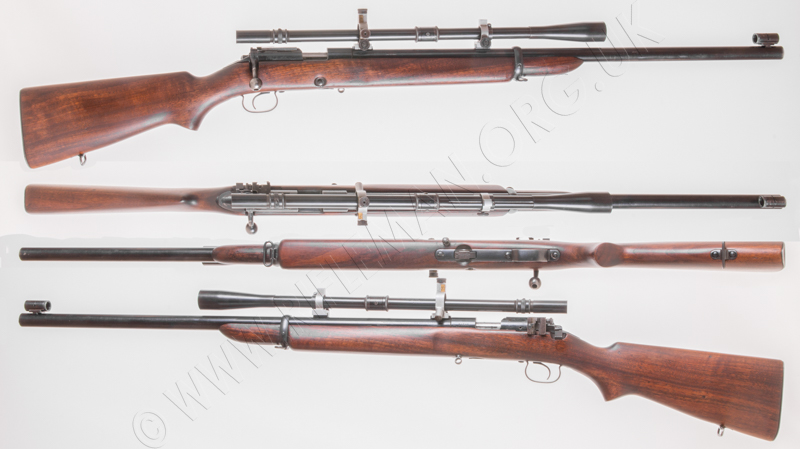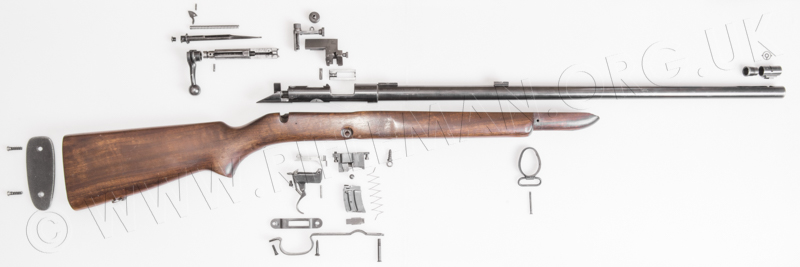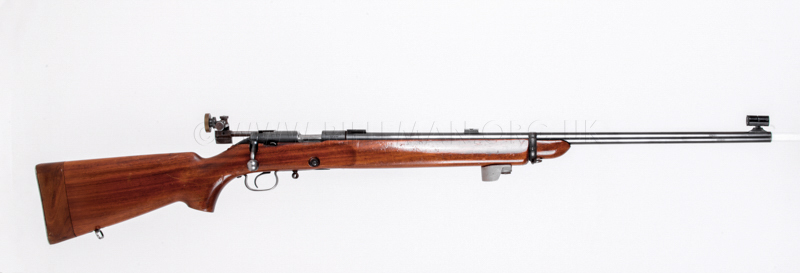The WINCHESTER MODEL 52 Target Rifles
See also the .22 Rimfire Winchester 1903 semi-automatic rifle used as a First World War training weapon
and other single-shot rifles contemporarily used in Britain.
Through the years, the Model 52, initially an immediately post-First World War design to provide the U.S. Government with a combination training/target rifle, underwent a number of modifications resulting in model marks A through E target rifles.
Production records show that just two rifles were manufactured in 1919, and the annual figures did not exceed 1,000 until 1925.
The rifle shown below was one of those experimental models shown at Caldwell, New Jersey, in 1919, and was the effective forebear of the Model 52.
Twelve of these rifles were built specially for the 1919 U.S. National Rifle Matches, and used in the International match, in which we sadly report that the British team were beaten! And not for the last time!


Production of the Model 52 commenced in 1920, and the rifle below was that as listed in Winchester's 1926 catalogue no.82.

The rifle was initially marketed at US$ 70.00, and the sales of only about 500 in the first eighteen months meant the price remained the same until its popularity resulted in an uplift in numbers sold, and a consequential drop in price to US$ 57.50 in 1922, with annual sales reaching a thousand two years later.
The 4,701 produced 1931 were the greatest quantity made in any one year until the huge uplift to 15,038 in 1956,
but this has been suggested to have been an error in the records,
even though the 1956-57 year-start serial numbers are listed as 81832 and 96870 respectively.
Although the figures for many of the following years approached 5,000, the 1931 total was never remotely matched,
and by the 1970s little more than 200 were made in any one year until production was halted with the Model 52-E.
A rifle design of remarkable longevity, it first commonly became available in Britain, as a civilian target rifle, in the early 1930s. The rifle also came onto the market in sporting guise later in the decade. By the commencement of the Second (1939-45) World War it was regularly imported as target rifle, but the War practically precluded further sales, although the Society of Miniature Rifle Clubs was still advertising it in their much abridged 1939 and 1940 catalogues.
Below: the 52-A with a contemporary Fecker 'scope.
These telescopes were marketed in the U.K. by Parker-Hale as their "Targetscope".
Hover over or Click image to bring up hi-res file and magnifier
Below is the disassembled Model 52-A shown above -
- serial number 19785 of 1931 production.
N.B. - The bolt requires
careful disassembly and reassembly with specific tools.
Carefully research the sequence of doing this before embarking on stripping.
There is considerable spring pressure on the striker,
and damage or injury may result if the correct procedure is not employed.
Next is a 1933 advertisement for the rifle giving useful specification detail.
Do not hold us to the exact figure, but we think that the $44 price of this rifle then equated to around £18 with an estimated exchange rate of $2.50 to the Pound. At that time, a BSA Model 12 Martini would have cost little more than £5, and a bolt-action .22 Mauser in the region of £9.

It will be seen that the rifle's vital statistics were at that time
Weight .....8 lbs. 10 ozs.
Barrel Length ........ 28"
Length overall ...... 45¾"
Stock Length ....... 13⅜"
Parker-Hale wrote that
"This is the standard American Small Bore Target Rifle as may easily be determined by a glance at the illustration in the "American Rifleman".
It is now euipped with a new 'Speed Lock' mechanism which reduces the lock time to less than one third the former time. The weight of the pull is easily and conveniently adjusted by means of a screw through the sear.
Bases are fitted to the barrel which are suitale for the Parker-Hale 9 x power "Targetscope" sight, which greatly adds to the interest of shooing by its improved aiming facilites and the fact that the shot holes can be dstinctly seen in the black at 100 yards immediately."
Parker-Hale understandably brought to contemporary shooters' notice the modification they made to their No.9 aperture target rear-sight that they had marketed with a bracket suitable for the Model 52. This was 'recommended' by the famous American Col. Townsend Whelen, who wrote much on small-bore rifles of the day, and whose small but comprehensive 1941 booklet entitled " Handbook on Small-bore Rifle Shooting" should be present on every collector's bookshelves. See BIBLIOGRAPHY
The company wrote of their updated sight ......
" THE PARKER-HALE MODEL 9A APERTURE SIGHT FOR THE WINCHESTER MODEL 52 RIFLE
Recommended by Colonel Townsend Whelen
The reason for this new sight is that the standard aperture backsight supplied with the rifle fails to satisfy the keen target rifleman, owing to (1) the absence of fine clicking movements for windage adjustment; (2) the fact that a single unalterable aperture is not suitable for all types of eyesight and the different firing positions taken up by various shooters[let alone varying range conditions; Ed].
The method of fitting the sight obviates the necessity for drilling and tapping the rifle, and permits the wind scale to be accurately centred. The adequate size of the adjusting screw heads are far more comfortable than those of the smaller sporting type of Receiver Sight.
Read Col. Townsend Whelen's criticism of the Parker-Hale Model.9 sight in the "American Rifleman" of April 1929.
"It goes right into the slot of the bridge on the receiver of the rifle made vacant when the factory sight is removed.
It will be noticed that the aperture is located under the windage bar instead of on top, which makes it easier to read the wind gauge with accuracy, and also shades the aperture from the effect of sunlight shining upon it. The elevation mechanism is quite similar to that on our Lyman No.48 sight. This sight has distinct clicks for both elevation and windage, registering 1/200 th. inch., for each click, which gives them a value of a minute of angle, or ¼" at 100 yards, and proportionately at other ranges".
The Parker Model 9A was indeed their equivalent of the Lyman 48J usually fitted in the U.S.A.
Note that, as in the text in the Parker-Hale catalogue above, Col. Townsend Whelen
preferred the placement of the eye-piece lug of the 9A beneath the windage arm,
as it gave clearer sight of the windage vernier.
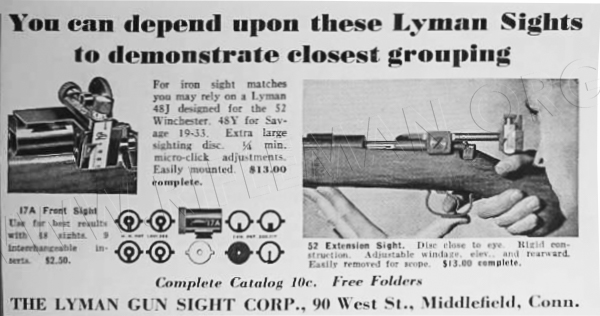
Obviously, Parker-Hale are referring to Col. Whelen's favourable criticism in this instance. It should be noted that this Parker-Hale Model 9 sght is NOT the same as the BSA Parker No.9 folding sight for the "Long-Lee" and S.M.L.E. rifles, which sight was designed and introduced far earlier, but was still being marketed contemporarily with the sight illustrated here.
The early model 52 with the fore-end barrel-band bears direct comparison with the prototype Remington Model 37 shown in the image below. The Remington was initially almost identically configured, but the military style band was removed before production reached more than a few hundred, cleaning up the stock and modernising its appearance.

image by courtesy of Dave Kern
The aforementioned sporting model was introduced in 1934, as shown in the next image.
Regrettably, it was not a rifle much seen in Great Britain.

That same year -1934 - saw Winchester proudly advertise a new World Record score
gained with their Model 52-A, an amazing 400 x 400 with 36 "X-ring" central hits,
shot by A.L. Darkow of Akro, Ohio.
This was then the highest individual Dewar course score made in International competition.
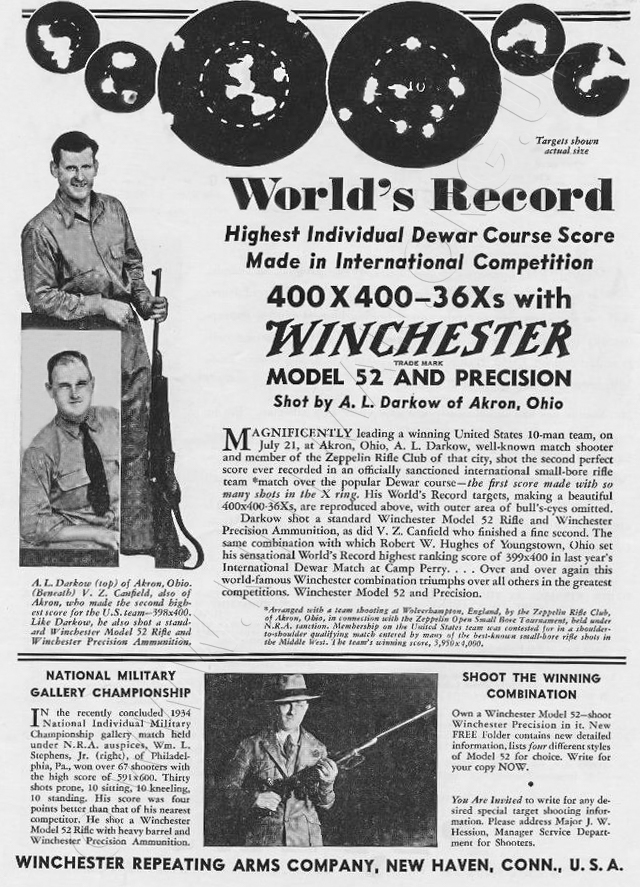
The early Model 52-B was of effectively the same configuration as the "A" Model.
The barrel-band was dispensed with on the later "B" Models.
The example below is of 1942 vintage.
For the rotational images on these pages,
drag horizontally to rotate subject.
Click to zoom and drag to pan.
Full screen viewing from expansion arrows.
The "52" developed a remarkably good reputation; it was accurate, reliable and had a fast lock-time, later further improved with modifications to the trigger mechanism and the longstanding "Speed-lock" design. The bolt travel was comparatively short and the rifle could be either magazine-fed or single loaded with a platform insert. Five or ten-round magazines were available.
Below: the later Model 52-B, its serial number dating it to 1949, fitted with the unusual Vaver dial rear-sight.
Another Model 52-B has been fitted with a Lyman "Targetspot" telescopic sight of similar vintage to the rifle.
The butt-stock has a raised comb to improve the hold of the rifle by bringing the shooter's eyeline closer to the sightline. With many rifles, shooting with a telescope over the standard rifle's butt tends to leave the firer's chin almost hovering in the air, rather than being firmly against the comb - which loose hold is not conducive to best accuracy.
This rifle, too, has a Verver dial sight for 'iron sights' shooting (its elevation arm has been removed while the 'scope is in use), and even these sights have a high sightline that requires a slightly higher head position than would be the case with the British Parker-Hale equivalent replacements.
And, yes, we know the butt sling-swivel was missing when the photographs were taken, but this has now been rectified.
By 1954 the "52" had developed to the Model C, when the trigger was upgraded, believed to have been after serial number 16,036. At £63, the rifle was more than twice as expensive as the BSA Martini International Mk.II now on the home market, the 'International' now being much in favour with British target-shooters.

Still on the market in 1963, the "52", in Model D form, was beginning to be a little long-in-the-tooth by comparison with the latest BSA Martini International Mk.III, Anschutz and Walther rifles, despite being given a fine trigger upgrade and fully-floating barrel in the meantime. The fine Remington 37 Rangemaster had already suffered the same fate in the late 1950s, but had had the 40-X to back it up until about the same time in 1963. The 40-x was the only rifle to stay beyond 1965. Prices had, by this time, evened out between the rifles of various nations. The 1963 price list in "The Rifleman", the journal of what was now the British " National Small-bore Rifle Association, illustrates how the American products had been caught up and overtaken by the others in every respect.
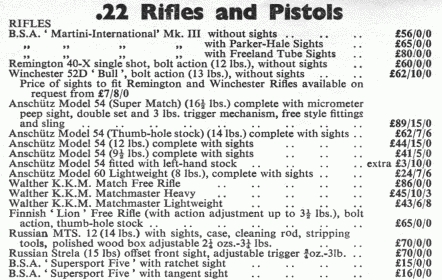
By 1970, these prices had increased by a further 35 to 40 percent.
Testament to the high regard in which these rifles have long been held, is their recent reintroduction into Winchester's range of classic rifles. You can now purchase a 'new' Model 52-B with a virtually unchanged specification to that offered on the original. As when that original was first sold more than fifty years ago, Winchester provide a pamphlet with each new rifle giving instructions for use, maintenance and cleaning. They have reproduced that production in the style of the original, but it has sadly been necessary for them to update the text to include all those tiresome requirements associated with current health and safety regulations, to obviate the litigation born in the USA and now prevalent in every aspect of life in the U.K. Sadly, the modern way is to blame anyone but one's self for one's own misfortune or carelessness. Accepting responsibility for your own actions nowadays seems an old-fashioned notion. Having said that, much of the basic advice given is just as it was last Century, and is as relevant today as it ever was. It should be treated as a timely reminder of how to properly handle any firearm.
The following is the main information contained in the 'new' leaflet for the 52-B
We hope the Company will appreciate the publicity and not resent replication of its advertising media! [Ed.]
IMPORTANT INSTRUCTIONS
FOR
MODEL 52B
.22 CALIBER BOLT ACTION RIFLE
This is one of the famous line of Winchester World Standard arms. As one of the Classic Traditions models you can expect the same quality and satisfaction as with the original historic Model 52B introduced in 1919. And, as with the original, you'll appreciate its economy of design, quick handling properties and smooth functioning.
U.S. REPEATING ARMS COMPANY, INC.
275 Winchester Avenue
New Haven, CT, U.S.A. 06511-1970
Winchester trademarks licensed from Olin Corporation.
Contents Page
Gun safety warnings .................................................... 3
General features ........................................................... 6
General description ...................................................... 8
Terminology and descriptions ..................................... 8
Serial number.............................................................. 10
Ammunition ............................................................... 10
General operation ...................................................... 11
Initial cleaning .......................................................... 11
Oiling the action ........................................................ 11
Operation of the safety............................................... 12
Cocking indicator ...................................................... 12
Inserting and removing the bolt ................................ 13
Loading........................................................................ 16
Unloading.................................................................... 18
Trigger System ............................................................ 19
Forearm adjustment screw ......................................... 20
Scope mount and sights ............................................. 20
Cleaning and maintenance suggestions ................... 21
Ordering parts ............................................................ 26
Service or repair ......................................................... 26
Questions @ Winchester.com .................................... 27
MODEL 52B BOLT ACTION 22 RIMFIRE
The Model 52 is what legends are made of. Your Model 52B offers the accuracy you want in a rimfire bolt action. It has the renowned Micro Motion trigger system. Producing a trigger system like this is labor intensive and requires extraordinary precision. Watch-like part fits like you see in a 52B are rare in these modern days. The match chamber adds further to the 52's exceptional accuracy. You may have already noticed how smooth and effortless it is to work the bolt. The magazine system, with its five shot capacity, is easy to operate and very reliable ... just like on the originals.
The history behind the Model 52 is equally extraordinary. It first appeared in 1919 and was shot at the National Rifle Matches that very year. It was a favorite of returning veterans after World War I because of its bolt action design that utilized a removable magazine. Many consider it one of the most significant factors in the growth of small-bore target shooting in the United States.
GUN SAFETY WARNINGS
IT IS ESSENTIAL THAT THESE OPERATING INSTRUCTIONS BE THOROUGHLY STUDIED BEFORE USING THIS FIREARM TO ASSURE PROPER AND SAFE GUN HANDLING. FAILURE TO FOLLOW THESE INSTRUCTIONS OR FAILURE TO OBEY ANY SAFETY WARNING MAY RESULT IN INJURY TO YOURSELF OR OTHERS, OR CAUSE DAMAGE TO YOUR GUN.
As a gun owner, you accept a set of demanding responsibilities. How seriously you take these responsibilities can be the difference between life and death. There is no excuse for careless or abusive handling of any firearm. At all times handle your rifle and any other firearm with intense respect for its power and potential danger.
PLEASE READ AND UNDERSTAND ALL OF THE CAUTIONS, PROPER HANDLING PROCEDURES AND INSTRUCTIONS OUTLINED IN THIS BOOKLET BEFORE USING YOUR NEW FIREARM.
- Do not carry a loaded gun with a live round in the chamber while walking, running, climbing a tree, crossing a fence or anywhere you might slip or fall, drop the gun or otherwise bump or jar the gun. A gun that is dropped, bumped, or jarred with a chambered round might accidentally discharge even with the safety on, causing serious injury to you or someone else. When a round is chambered keep the safety on until you are ready to shoot.
- Do not rely on the safety to prevent accidental discharge. Many safeties merely block the trigger and prevent firing by pulling the trigger. The safety may not prevent an accidental discharge due to dropping, jarring, or bumping a gun.
- Use only ammunition for which the gun is chambered as indicated on the barrel, to prevent excessive pressure and possible serious personal injury.
- Incorrectly reloaded ammunition can cause serious personal injury and damage to the firearm due to excessive pressure. Reload only after proper instruction and in strict compliance with instruction and data contained in current reloading manuals.
- Never point a gun at anything you do not intend to shoot. Always keep it pointed in a safe direction in case of accidental discharge.
- Always check to ensure that the barrel is free of obstructions before loading and using the gun. If you experience light recoil or off sound, check the barrel for an obstruction.
- Before firing, clean any grease or oil out of barrel with cleaning rod and patch. Grease or heavy accumulation of oil can cause excessive pressure and result in serious personal injury.
- Keep barrel, chamber and action free of rust. Rust in the barrel and chamber can cause excessive pressures resulting in serious injury. A rusted, pitted or eroded barrel should be replaced.
- Use hearing protection to prevent ear damage from repeated exposure to gunfire.
- Always use proper shooting glasses to prevent eye injury from flying particles.
11. Never carry a loaded gun in a motor vehicle or carry one into a dwelling. Always carefully unload
the gun before entering a motor vehicle, a dwelling or an area such as a camp. Always point a gun in a safe direction while loading or unloading to prevent serious injury in case of an accidental discharge. Never load in the house or in your vehicle.
- Never shoot at a hard, flat surface or at the surface of water to avoid a ricochet and possible serious personal injury to yourself or a bystander.
- Store your gun in a clean, dry place out of the reach of children and separated from stored ammunition.
- Never alter any parts of your gun. Any alterations or adjustments that may become necessary to the operating mechanism should be performed by a qualified gunsmith.
- Hunting from elevated surfaces such as tree stands is dangerous. Doing so may increase the risk of handling any firearm. Always make certain that the stand being used is safe, sturdy and stable. Always make certain your firearm is unloaded when it is being taken up and down from the stand. Always make certain that your firearm is not dropped from the stand or dropped while it is being taken up or down from the stand.
16. Discharging firearms in poorly ventilated areas, cleaning firearms, or handling ammunition may result in exposure to lead and other substances known to cause birth defects, reproductive harm and other serious physical injury. Have adequate ventilation at all times. Wash hands thoroughly after exposure.
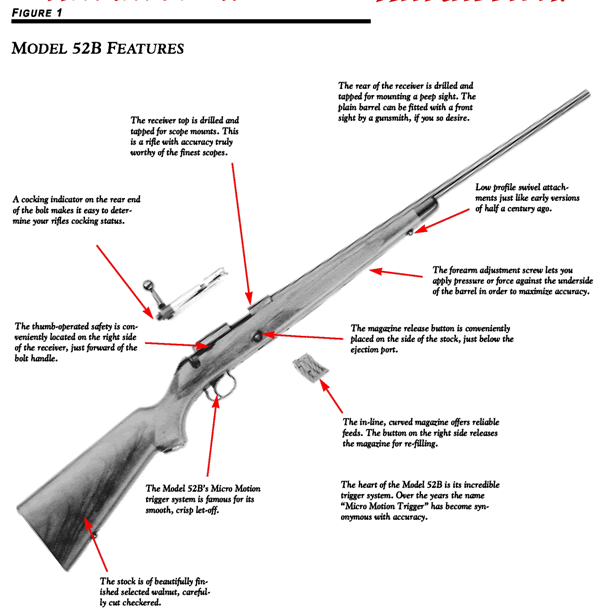

GENERAL DESCRIPTION
Your new Winchester Model 52B is a reproduction of the original Model 52B "Sporting" bolt action. It features the highly regarded trigger system. Other features of the Model 52B include the side safety, the black forearm tip, the special quick-release swivel mounts on the forearm and stock, and the convenient five-shot removable magazine (additional spare magazines can be purchased from your Winchester firearms dealer).
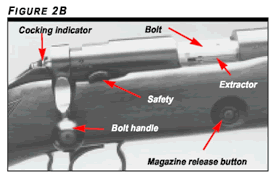
The Model 52B comes with the receiver drilled and tapped to accept commercially available rear peep sights and scope mounts. A two-piece scope mount base and high scope mount rings are available as accessories. (Front sights must be installed by a qualified gunsmith.)
TERMINOLOGY AND DESCRIPTIONS
Descriptions in this booklet generally refer to the gun in the horizontal position. That is, in the normal firing position. For example, the muzzle is forward or front; the butt stock is rearward or rear; the trigger is downward or underneath; the sights are upward or on top. Figure 1 covers the general features and benefits of the Model 52B design.
For general parts terminology, refer to Figure 2A and 2B. With the exception of magazine disassembly, figure 2A also shows the Model 52B disassembled to the extent necessary in order to follow instructions contained in this book.
Throughout this manual the "action" refers to the
mechanism of this rifle which loads and secures the cartridges in the chamber.
SERIAL NUMBER
The serial number can be found on the right hand side of the receiver.
Record the serial number at the front of this book for future reference.
AMMUNITION
The caliber of your Model 52B is inscribed on left side of the barrel, toward the receiver.
The Model 52B must be used only with .22 Long Rifle cartridges. It is unsafe to attempt loading magnum cartridges in a rifle designed for Long Rifle cartridges.
U.S. Repeating Arms Co. can assume no responsibility for incidents which occur through use of cartridges of nonstandard dimension or those developing pressures in excess of SAAMI (Sporting Arms and Ammunition Manufacturer's Institute) established standards.
Winchester ammunition is always an excellent choice for your new Winchester rifle, delivering the unmatched performance and dependability you want.
DISCHARGING FIREARMS IN POORLY VENTILATED AREAS, CLEANING
FIREARMS, OR HANDLING AMMUNITION MAY RESULT IN EXPOSURE TO LEAD AND OTHER SUBSTANCES KNOWN TO CAUSE BIRTH DEFECTS, REPRODUCTIVE HARM AND OTHER SERIOUS PHYSICAL INJURY. HAVE ADEQUATE VENTILATION AT ALL TIMES. WASH HANDS THOROUGHLY AFTER EXPOSURE.
GENERAL OPERATION
The Model 52B is a bolt action rifle that operates by lifting the bolt handle, drawing the bolt rearward and then sliding the bolt forward and rotating the bolt downward until it locks into battery position. This process takes a cartridge from the magazine and loads it into the chamber for firing.
CAREFULLY READ THE FOLLOWING PROCEDURES BEFORE ATTEMPTING TO SHOOT YOUR MODEL 52B RIFLE.
INITIAL CLEANING
BEFORE THE FIRST FIRING, CLEAN THE BORE WITH A CLEANING ROD & PATCH. ALSO, CLEAN THE ANTI-RUST COMPOUND FROM THE INSIDE OF THE RECEIVER WITH A CLEAN RAG AND LIGHT GUN OIL. SEE "CARE AND CLEANING" LATER IN THIS MANUAL.
OILING THE ACTION
Before the first firing you should wipe the mechanism completely clean, clean the bore and apply a few drops of oil on the following surfaces:
- Along the breech bolt surface and where the sleeve contacts the breech bolt.
- Along the breech bolt surfaces on the receiver where the bolt contacts the receiver as it is worked.
Avoid applying too much oil. Only a light film is necessary. Cleaning and Maintenance Suggestions should be followed before each oiling.
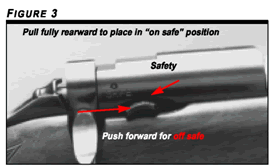
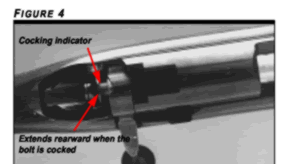
OPERATION OF THE SAFETY
The safety is located on the right side of the receiver (Figure 3). When the safety is clicked (or is detented) into position toward the rear, the gun is in the "on safe" position as shown. In this position the trigger is blocked. "Safe" is stamped on the receiver to mark this "on safe" position .
WHENEVER A CARTRIDGE IS CHAMBERED, THE SAFETY SHOULD BE MOVED TO THE "ON SAFE" POSITION UNTIL YOU ARE READY TO FIRE IT.
When the safety is pushed forward, the rifle is in the "off safe" position and ready to fire.
COCKING INDICATOR
—
The rear end (or shroud) of the bolt serves as a cocking indicator. When the bolt is in the rifle and is
cocked the indicator will appear (see Figure 4) — extending rearward forming a gap between the pointed
surface on the indicator and the pointed recess on the
bolt (Note: there is a pointed surface on top and bot‑
tom of the shroud). When the rifle is fired, the cocking indicator (entire shroud) moves forward, closing
the gap.
INSERTING AND REMOVING THE BOLT
INSERTING THE BOLT—
The Model 52 rifle comes packaged with the bolt removed from the rifle. It is necessary to insert the bolt into the receiver.
WARNING: REMOVE THE MAGAZINE AND MAKE SURE THE RIFLE IS FULLY UNLOADED BEFORE PROCEEDING.
To insert the bolt the safety must be placed in the "off safe"position.
1. The front and rear portions of the bolt must be aligned properly before it can be inserted. The bolt handle (and connected locking surface) can rotate with respect to the bolt body itself. If not already in alignment the parts must be realigned. To do this:
a)Take the end of the bolt body in one hand and the bolt handle in the other.
b)Twist the handle to align the top and bottom pointers on the shroud with the grooves cut in the bolt.
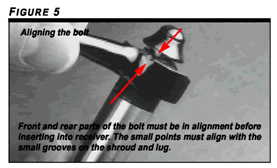
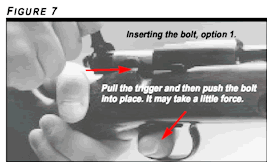
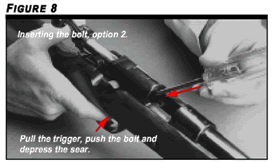
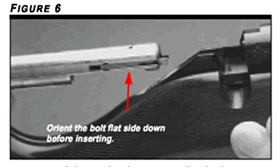
The top groove is on the polished portion of the top lug (see Figure 5). The bottom groove is on the rear of the bottom lug.
- Align the end of the bolt in the rear opening of t receiver as shown (see Figure 6).
- While pulling the trigger, push the bolt forward and shove it in the receiver, past the point where it stopped by the sear (see Figure 7). This may take a little force, but not too much. Optional: The sear c be depressed with a screwdriver for easier insertion (see Figure 8). This makes it much easier to insert t bolt.
4. Release the trigger and rotate the bolt handle down to lock it.
CAUTION: The chamber should be empty — if there is a round in the chamber, the rifle can be fin if the trigger is pulled.
WPM
5. Return the safety to the "On Safe" position. The rifle is now assembled and may be operated normally
REMOVING THE BOLT—
BEFORE REMOVING THE BOLT FULLY UNLOAD YOUR RIFLE: REMOVE THE MAGAZINE FROM THE RIFLE AND OPEN THE BOLT. VISUALLY ASSURE THAT THE CHAMBER IS EMPTY.
- The firing mechanism must be uncocked before the bolt can be removed. With the rifle fully unload ed and pointed in a safe direction, close the bolt, then uncock the bolt by dry firing the rifle.
- With the bolt now uncocked, insert your finger behind the trigger and push it forward as shown (Figure 9). You must push the trigger before you open the bolt or the bolt will not release.
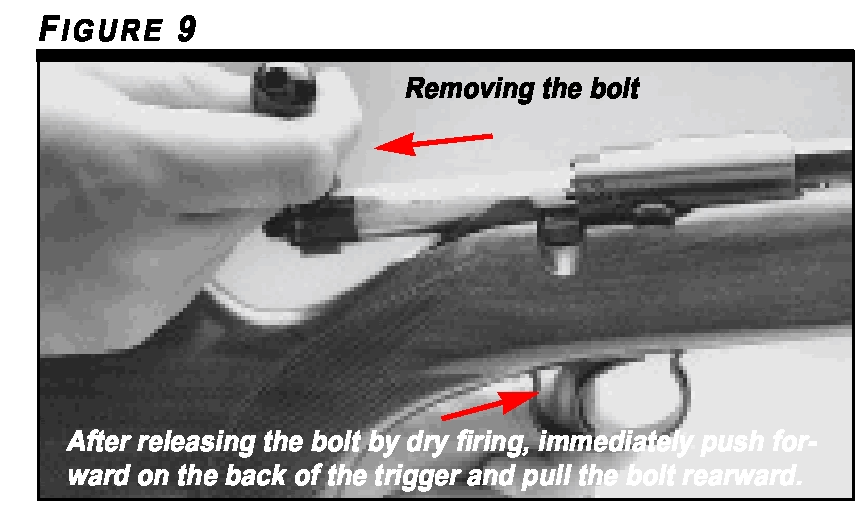
- While still pushing forward on the trigger, open the bolt, and pull the bolt rearward out of the receiver.
- To re-insert, refer back to "Inserting the Bolt" section.
LOADING
The Winchester Model 52 is furnished with a five-shot removable magazine. Follow the instructions below for loading:
CAUTION: WHILE LOADING AND UNLOADING, MAKE SURE THE SAFETY IS IN THE "ON SAFE" POSITION WHEN THE BOLT IS CLOSED. ALWAYS POINT YOUR RIFLE IN A SAFE DIRECTION
LOADING THE MAGAZINE —
To load the magazine, always remove it from the rifle (see Unloading Your Model 52 later in this manual).
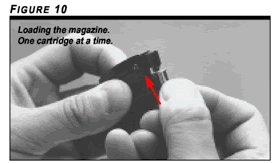
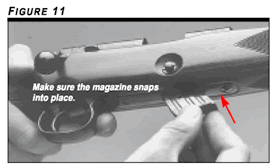
Load one cartridge at a time (see Figure 10). Repeat until the magazine is filled to capacity (five rounds).
INSERTING THE MAGAZINE INTO THE RIFLE —
Before inserting the magazine into the rifle, close and lock the bolt. Carefully push in the magazine until it locks (detents) into place with an audible snap (Figure 11)
LOADING A CARTRIDGE INTO THE CHAMBER FROM THE MAGAZINE —
With the magazine in place, close the bolt (if it is open), and a round will be fed into the chamber. If the bolt is closed, completely cycle the bolt to place a
round from the magazine into the chamber.
CAUTION: THE RIFLE IS NOW READY TO FIRE BY PULLING THE TRIGGER. IMMEDIATELY PLACE THE SAFETY IN THE "ON SAFE" POSITION UNLESS FIRING IS IMMINENT.
LOADING TO FULL CAPACITY —
If you manually load a round in the chamber, the capacity of the Model 52 can be increased to six rounds.
After the round is in the chamber, close the bolt. Then, insert the magazine.
CAUTION: MOVE THE SAFETY TO THE "ON SAFE" POSITION.
DO NOT CARRY A ROUND IN THE CHAMBER UNLESS SHOOTING IS IMMINENT.
Also, you can load the rifle to full capacity by, first, cycling in a round from the magazine into the chamber. Leave the bolt closed. Remove the magazine. Refill it to capacity, then, reinsert it.
CAUTION: KEEP THE SAFETY IN THE "ON SAFE" POSITION.
UNLOADING
ALWAYS REMEMBER TO PLACE THE SAFETY IN THE "ON SAFE" POSITION WHEN THE BOLT IS CLOSED.
POINT THE MUZZLE IN A SAFE DIRECTION WHEN UNLOADING.
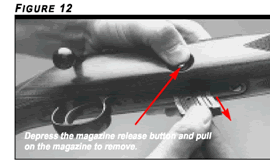
1. Take the magazine out of the rifle. With the rifle horizontal, depress the magazine release button.
Pull the magazine out (see Figure 12).
- Remove the cartridge from the chamber. Cycle the bolt open and the cartridge will eject. Leave the bolt open.
- To fully unload the magazine, strip each cartridge from the magazine until it is empty.
CHECK THE CHAMBER TO BE ABSOLUTELY CERTAIN IT IS UNLOADED.
TRIGGER SYSTEM
The Model 52 trigger system is famous for its clean, crisp pull. Trigger pull on the Model 52B is pre-set at the factory at approximately 6 1/2 pounds.
ANY ADJUSTMENT, DISASSEMBLY OR SERVICE OF ANY PART OF THE TRIGGER SYSTEM MUST BE PERFORMED BY A QUALIFIED GUNSMITH ONLY.
FOREARM ADJUSTMENT SCREW
Some original Model 52B rifles were supplied with a forearm adjustment screw. Your new Winchester Model 52B is also supplied with this feature. The adjustment screw is located on the underside of the fore-end, in the center of the middle checkering diamond.
This feature was very popular with some avid target shooters a number of years ago. It allows you to apply pressure or force against the bottom of the barrel itself — a feature used to aid in tuning a barrel to dif ferent ammunition.
You may wish to experiment with this feature, applying a slight bit of pressure by turning the screw clock wise with a small screwdriver until the end of the screw contacts a special surface on the underside of the barrel.
In our testing, with MODERN AMMUNITION, the new Model 52B has shown to shoot its best with the screw not touching the barrel and the barrel free floating. Consequently the screw comes from the fac, tory in the fully out position, not touching the barrel
SCOPE MOUNT & SIGHTS
The receiver is drilled and tapped to accept scope mount bases on the receiver (see Figure 13). A two-piece scope mount base and high scope mount rings are available as accessories. See your Winchester firearms dealer for details.
The Model 52 also comes drilled and tapped for a precision target-type peep sight (refer again to Figure 13). There are several types to choose from. Your dealer can help you with this as well.
Always fully unload your rifle before making any adjustment to your scope or sights. Adjust the scope any sights you choose according to manufacturer's instructions.
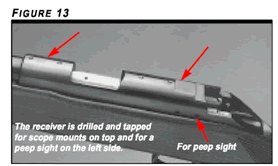
CLEANING AND MAINTENANCE SUGGESTIONS
Your rifle will function better and more reliably over a longer period of time if it is properly maintained and kept clean.
BEFORE PERFORMING ANY CLEANING PROCEDURES, ALWAYS MAKE CERTAIN THERE ARE NO CARTRIDGES IN THE CHAMBER, MAGAZINE OR ACTION/FEED AREAS.
You should clean your rifle after every day of shooting and more often if it becomes excessively dirty. If shooting for extreme accuracy your rifle should be cleaned after every 50 shots or even as few as every 25 shots under competitive conditions.
A minimum cleaning includes wiping down the action and oiling key parts. Most regular maintenance will also include cleaning the barrel. If you encounter a function problem (tight action when working the bolt), be sure to give your gun a thorough cleaning to see if it solves the problem before
seeking the services of our service facility or a competent gunsmith.
To clean your firearm, follow the general outline below:
CLEANING PROCEDURES —
BE CERTAIN YOUR GUN'S CHAMBER ANC MAGAZINE ARE UNLOADED. ALWAYS WEAR PROTECTIVE SAFETY GLASSES DURING ALL CLEANING PROCEDURES. KEEP AMMUNITION AWAY FROM THE CLEANING AREA. DO NOT TEST THE FUNCTION OF YOUR FIREARM WITH LIVE AMMUNITION.
The correct procedure for cleaning your rifle is as follows:
BE CERTAIN THE RIFLE IS UNLOADED AND THE BOLT HAS BEEN REMOVED. ALWAYS WEAR EYE PROTECTION WHEN CLEANING YOUR RIFLE.
ALWAYS PLACE THE SAFETY IN THE "ON" (SAFE) POSITION BEFORE BEGINNING ANY CLEANING PROCEDURE.
REMOVE THE BOLT FROM YOUR RIFLE AS EXPLAINED PREVIOUSLY.
- Use a cleaning rod with a tip and patch suitable for the caliber of your rifle's bore. Make sure the patch is large enough for a snug fit in the bore. Insert the rod and patch into the barrel at the receiver end and run it back and forth several times. Use a crown protector if you are cleaning from the muzzle end of the barrel. Damage to the crown of a barrel can affect the accuracy of your rifle.
- Inspect the chamber and bore for brass, copper and powder fouling. A normal amount of powder
residue can be expected and is not serious. It can usually be removed by repeating step one, using a patch saturated with solvent. If or when fouling should become heavy, it can be removed with a brass bore brush. Dip or spray the brush with solvent and scrub the chamber and bore until the fouling is removed. To prevent brass bristles from breaking off, the brush should be pushed completely through the bore before being withdrawn.
- After fouling has been removed the bore should be wiped dry. Then pass a slightly oiled patch through the bore, for preservation. A fine, light gun oil is recommended.
- Wipe all exposed metal surfaces of the receiver, forearm and barrel with a clean rag. Finger marks should be removed because they provide a place where moisture can accumulate. Any dried oil in the receiver area should also be removed.
- Lightly oil your gun at the points described under "Oiling the Action" explained earlier in this manual. Ordinary good judgment will, of course, indicate that the metal of the gun should receive a light film of oil any time the rifle has been exposed to weather or handling. This is very important and must be done with every rifle — even stainless steel models. Remember, the polished, finely fitted surfaces of the receiver and action mechanisms must always have a thin film of oil. Make sure that the surfaces of the breech bolt are especially clean and lightly oiled with a high quality gun oil. Do not use pure silicone or lanolin.
- INSPECT THE BARREL AND CHAMBER. TO MAKE CERTAIN THAT NO PATCHES HAVE BEEN INADVERTENTLY LEFT IN THEM. Remove any that remain.
- Wipe all wood surfaces.
- When transporting only, store your rifle in a quality protective case to prevent scratches and dents. Store in a dry place to prevent corrosion. Store away from children.
MAKE SURE YOUR RIFLE IS UNLOADED AND ALWAYS STORE AMMUNITION SEPARATELY.
CLEANING THE MAGAZINE —
Disassembly: Depending on how often you shoot, it is helpful to disassemble the magazine for cleaning. First, with one finger depress the retainer catch spring button on the bottom of the magazine, and slide the plate off, away from the rounded end of the magazine. Remove the spring and follower and wipe clean. The magazine is now fully disassembled (see Figure 14). Lightly oil the internal parts.
Reassembly: Reinsert the spring, follower and base retainer, then slide the plate back onto the magazine. Be sure the magazine base retainer is correctly aligned with the magazine and the spring's loop is anchored to the plate divot (refer again to Figure 14).
DO NOT TAKE YOUR GUN'S ACTION APART BEYOND THE EXTENT EXPLAINED IN THIS MANUAL.
This is a specialized, finely fitted mechanism, and you may mar it for life by an attempt to disassemble the inner mechanism assemblies. If further disassembly is required, contact the U.S. Repeating Arms Company special Arnold, Missouri Service Facility.
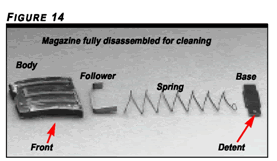
OTHER CLEANING SUGGESTIONS -
- Never pour large quantities of oil into the receiver or other parts. It can drain down to the wood and soften it — and cause permanent damage and loosening of the stock.
- After extended periods of heavy use, your gun should be taken to a qualified gunsmith to have the action disassembled for professional cleaning and lubrication.
NEVER ATTEMPT TO TAKE YOUR MODEL 52B APART FURTHER THAN EXPLAINED IN THIS MANUAL.
This is a specialized, finely fitted mechanism. You may permanently mar it by attempting to disassemble the inner mechanism assemblies. If further disassembly for service or cleaning is required, take your gun to a U. S. Repeating Arms Company recommended Service Center or a competent gunsmith as explained under "Service or Repair.
CAUTION: PARTS ARE MADE FOR WINCHESTER BRAND FIREARMS MANUFACTURED BY OR FOR U.S. REPEATING ARMS COMPANY, INC., AND SHOULD NOT BE USED IN OTHER GUNS EVEN THOUGH MODELS MAY BE SIMILAR. IMPROPERLY FITTED PARTS MAY BE DANGEROUS.
The 21st. Century Winchester 52B Manual (PDF)
Below: the Model 52-C, its serial number dating it to late 1961, is fitted with the more usual Redfield rear-sight.
The Winchester 52E was the last model in the late 1970s, and the final series included the International Match rifle with thumbhole stock -
- as shown in the 1976 catalogue and specification sheet below.
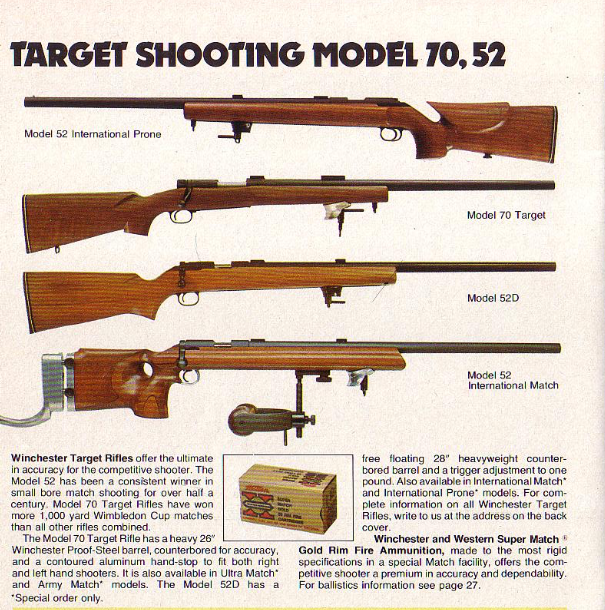
Many vintage Winchester catalogues are available from the International Ammunition Association
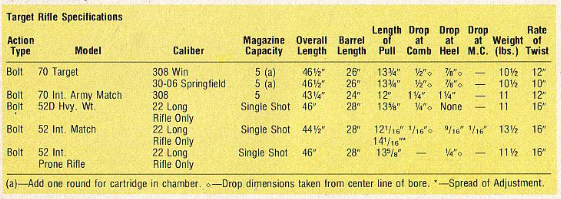
See also the .22 rim-fire Winchester 1903 semi-automatic rifle as a First World War training weapon
the Winchester .22LR rifles used by Great Britain during the Second World War 1939-45
and the Winchester Winder Musket
Return to: TOP of PAGE
See this website's Raison d'être
